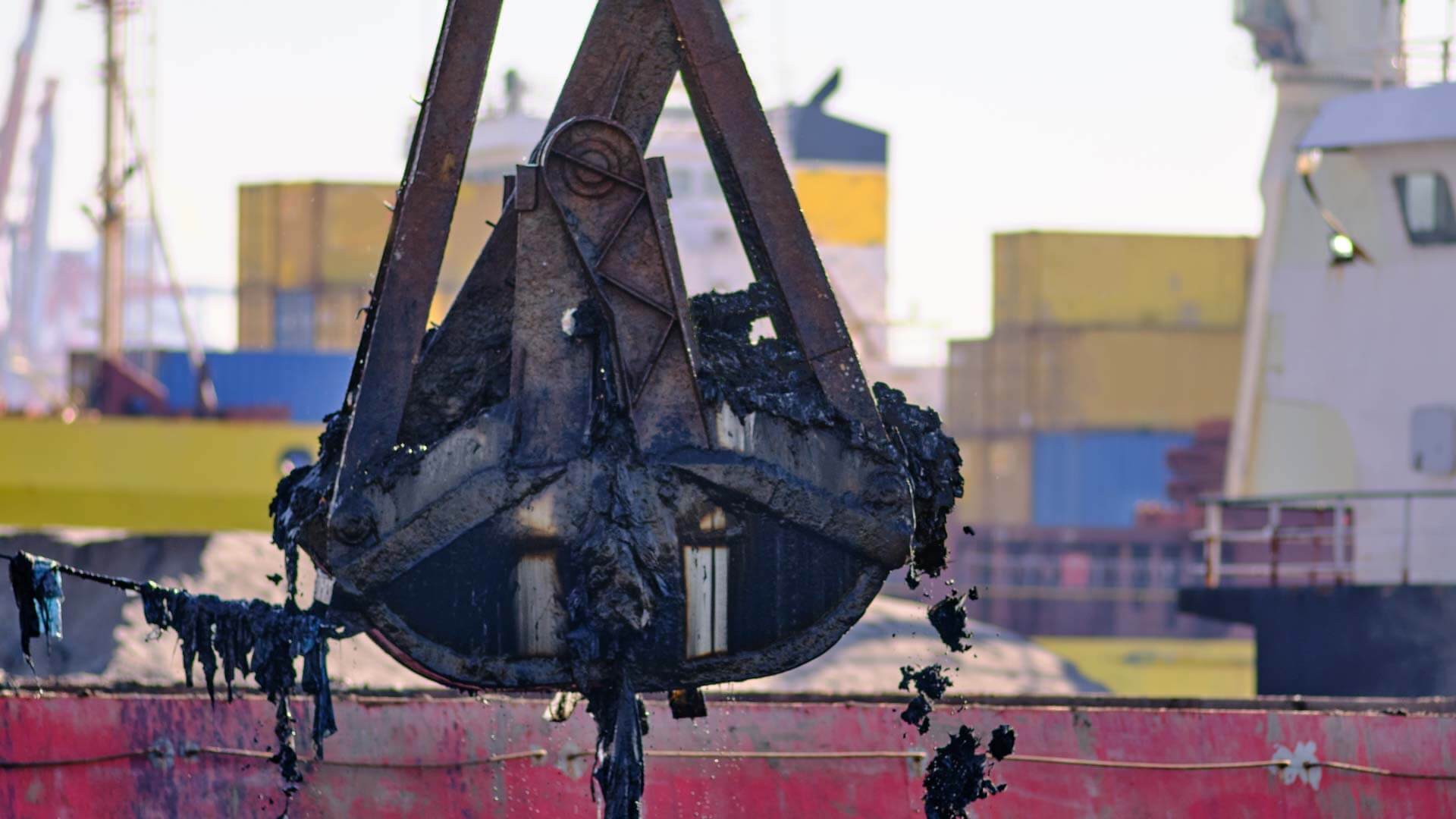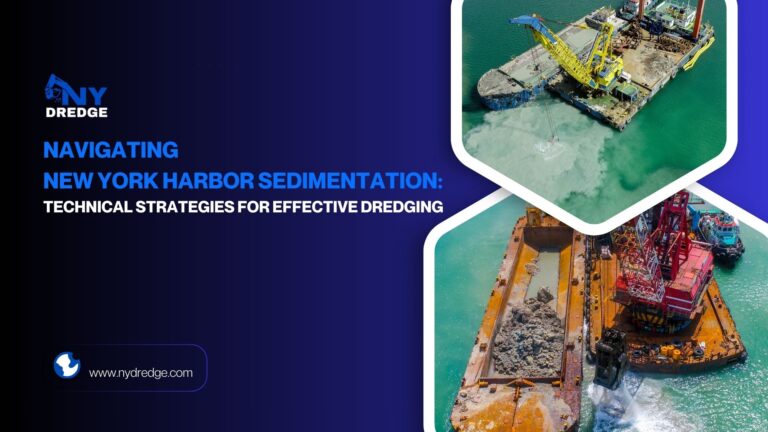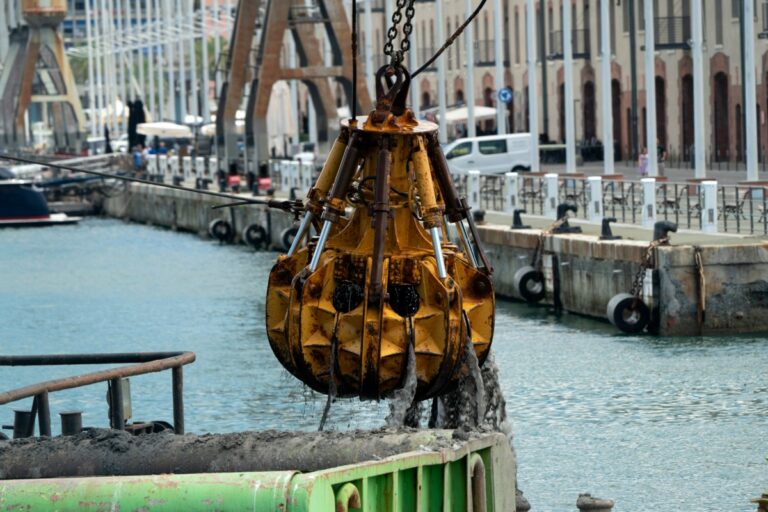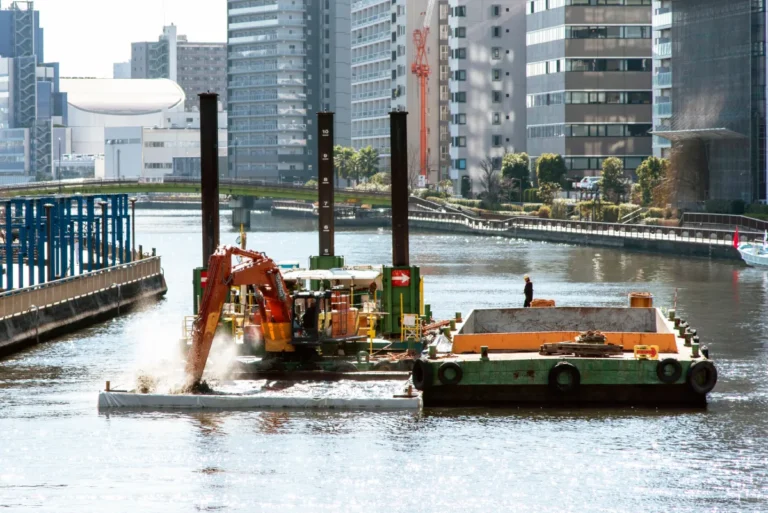Mechanical dredging plays a critical role in maintaining waterways, supporting construction projects, and facilitating mining and resource extraction. Unlike hydraulic dredging, which relies on suction to transport material, mechanical dredging involves the direct excavation and removal of sediment, rocks, and debris using heavy machinery such as clamshell buckets, backhoes, and draglines. The precision and control provided by mechanical dredging make it ideal for projects that require targeted material removal or operation in confined spaces. This makes it especially valuable in ports, harbors, and near sensitive infrastructure where accuracy is essential.
While the advantages of mechanical dredging include greater precision and the ability to handle compacted or heavy materials, it also presents unique challenges. One of the most significant issues faced by operators is equipment wear and tear. The repetitive action of digging, lifting, and moving abrasive materials such as sand, gravel, and rock can cause structural fatigue and degrade key components over time. Exposure to saltwater, harsh weather conditions, and corrosive materials further accelerates wear, leading to increased maintenance costs and potential equipment failure.
The purpose of this article is to explore advanced maintenance strategies to reduce wear and tear in mechanical dredging equipment. By implementing proactive maintenance techniques, using wear-resistant materials, and adopting predictive maintenance technologies, operators can extend the lifespan of their dredging equipment and improve overall operational efficiency. Additionally, understanding the differences between hydraulic vs mechanical dredging can help dredge operators select the right maintenance strategies for their specific equipment and project needs.
Understanding Mechanical Dredging
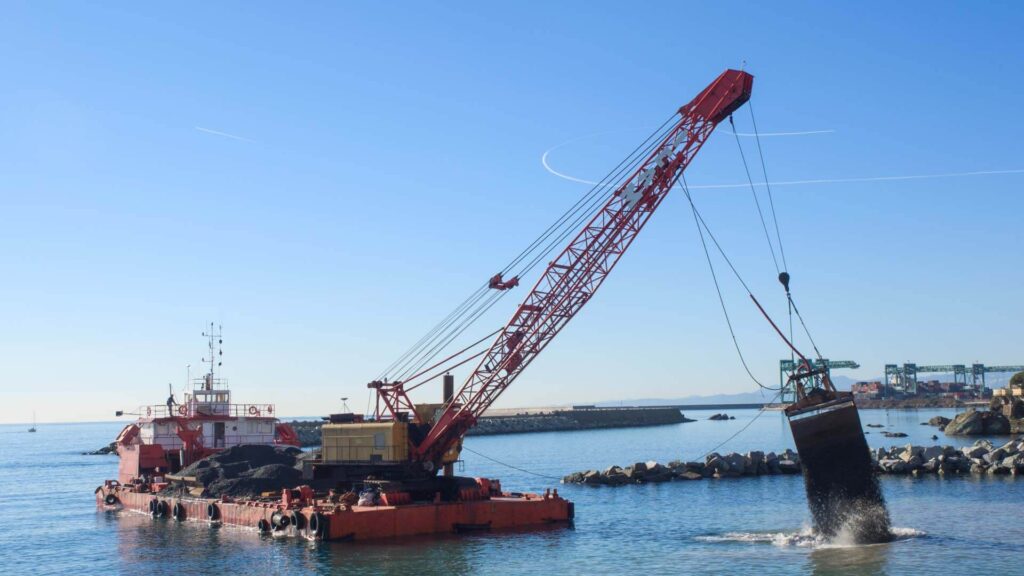
What is Mechanical Dredging?
Mechanical dredging is the process of removing sediment, debris, and other materials from the bottom of waterways using heavy machinery and mechanical equipment. Unlike hydraulic dredging, which relies on suction and pumping systems to transport material, mechanical dredging physically excavates material with equipment such as clamshell buckets, backhoes, draglines, and excavators. This makes mechanical dredging particularly effective for handling heavy, compacted, or coarse materials that are difficult to move using suction-based methods.
Mechanical dredging is commonly used in ports, harbors, rivers, and lakes where targeted material removal is necessary. It is also ideal for maintaining navigational channels, removing debris from construction sites, and conducting environmental remediation projects. The ability to precisely control the excavation and removal process allows for greater accuracy, making mechanical dredging suitable for projects where minimal disruption to surrounding ecosystems or infrastructure is essential.
Overview of Mechanical Dredging Methods
Several methods are used in mechanical dredging, depending on the project’s requirements and site conditions:
- Clamshell Dredging – Involves using a large bucket (clamshell) attached to a crane or excavator to scoop and lift sediment. Effective for deep-water dredging and targeted material removal.
- Bucket Dredging – Similar to clamshell dredging, but involves a continuous chain of buckets for increased efficiency. Suitable for removing large volumes of material.
- Backhoe Dredging – Uses a backhoe or excavator positioned on a barge to remove sediment. Ideal for shallow water and near-shore dredging.
- Dragline Dredging – Involves a dragline bucket attached to a long boom that scoops material. Effective for large-scale excavation projects.
Key Differences Between Hydraulic vs Mechanical Dredging
The primary difference between hydraulic vs mechanical dredging lies in the method of material removal and transport:
- Hydraulic dredging uses suction to transport material through pipelines, making it suitable for fine materials such as silt and clay.
- Mechanical dredging physically excavates material, making it more effective for handling heavy, coarse, and compacted materials.
- Hydraulic dredging allows for continuous operation, while mechanical dredging offers greater precision and control over material placement.
Advantages of Mechanical Dredging
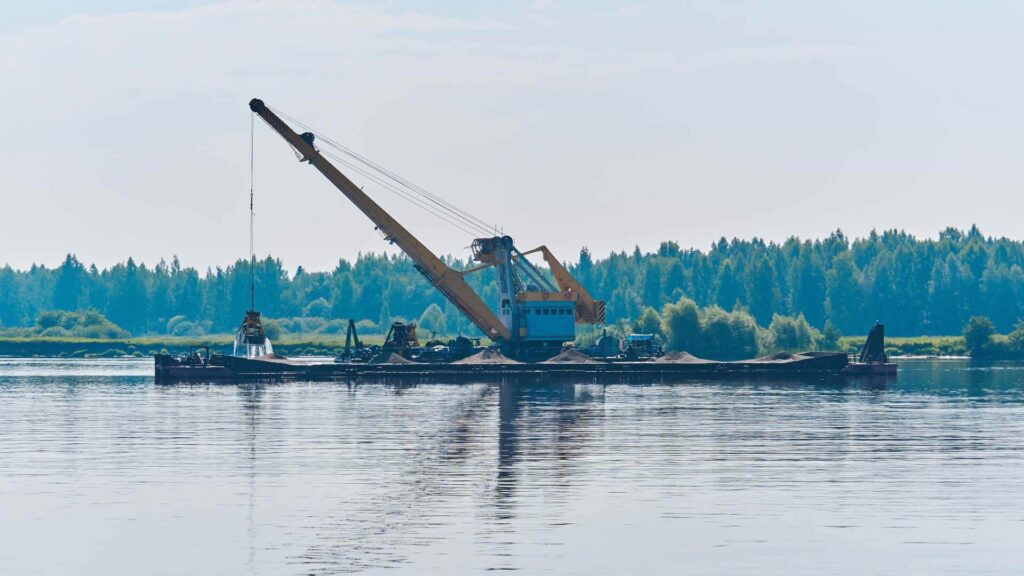
Mechanical dredging offers several advantages over hydraulic dredging, making it the preferred method for certain projects:
- Greater Precision and Control
Mechanical dredging provides enhanced control over material removal, allowing operators to target specific areas and depths accurately. This is especially important for projects near docks, bridges, and other structures where precision is critical.
- More Effective for Hard or Compacted Materials
Mechanical dredging is well-suited for removing heavy and compacted materials such as rock, gravel, and debris that hydraulic dredging systems may struggle to handle. The mechanical force of buckets and excavators allows for more efficient excavation of tough materials.
- Ideal for Shallow Water and Confined Spaces
Unlike hydraulic systems, which require large suction lines and extensive infrastructure, mechanical dredging equipment can operate effectively in shallow water and confined spaces. This makes it ideal for dredging near shorelines, docks, and industrial facilities.
- Ability to Operate in Varied Weather Conditions
Mechanical dredging equipment is less affected by weather and water conditions compared to hydraulic systems. High currents and turbulent water can disrupt hydraulic pipelines, but mechanical dredging equipment remains effective in challenging environments.
Challenges of Mechanical Dredging
While mechanical dredging offers significant benefits, it also presents unique challenges that can impact operational efficiency and equipment lifespan:
- High Levels of Equipment Stress and Wear
The repetitive action of digging, lifting, and transporting heavy materials places significant stress on dredging equipment. Components such as buckets, cutting edges, and booms are subject to constant wear, leading to material fatigue and potential failure if not properly maintained.
- Exposure to Abrasive Materials and Harsh Environments
Mechanical dredging often involves handling abrasive materials such as sand, gravel, and rock, which can quickly wear down metal surfaces and cutting edges. In saltwater environments, corrosion can accelerate equipment degradation, increasing the need for regular maintenance and part replacement.
- Potential for Increased Maintenance Costs
The physical nature of mechanical dredging increases the likelihood of equipment damage and breakdown. Replacing worn components, repairing structural damage, and maintaining hydraulic systems can lead to higher operational costs over time.
Common Causes of Equipment Wear and Tear in Mechanical Dredging
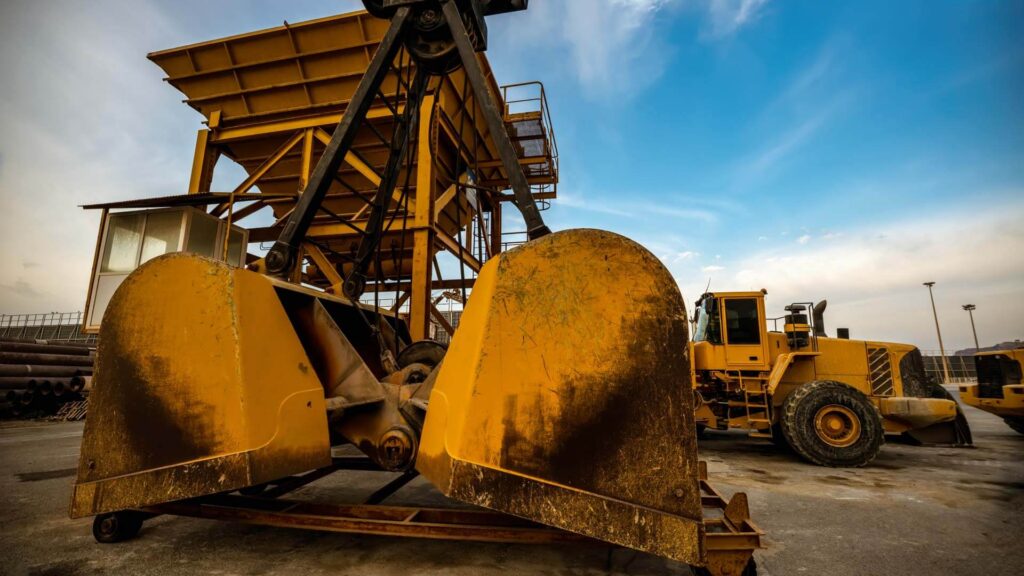
Equipment wear and tear is a significant challenge in mechanical dredging operations. The demanding nature of dredging, combined with exposure to harsh materials and environmental conditions, can quickly degrade equipment performance and lead to costly downtime. Understanding the primary causes of wear and tear allows operators to implement effective maintenance strategies and extend the lifespan of their equipment. Below are the most common factors contributing to equipment degradation in mechanical dredging:
1. Abrasive and Corrosive Materials
The materials encountered during mechanical dredging are often abrasive and corrosive, leading to accelerated wear on key components.
- Impact of Sand, Gravel, and Sediment on Cutting Edges and Buckets
The repeated action of scooping and lifting coarse materials such as sand, gravel, and sediment places immense strain on dredging equipment. Cutting edges, buckets, and teeth experience constant friction and impact, causing them to wear down quickly. Hardened steel and other protective coatings can reduce damage, but regular exposure to abrasive materials inevitably causes surface degradation.
- Corrosion Caused by Saltwater and Chemical Exposure
Operating in saltwater or chemically contaminated environments increases the risk of corrosion. Salt and chemicals can weaken metal components, leading to pitting, cracking, and structural failure. Corrosion also accelerates the wear of hydraulic lines and seals, potentially causing leaks and reduced system pressure. Without proper coatings or anti-corrosive treatments, equipment lifespan is significantly reduced in these environments.
Structural Fatigue and Stress
Mechanical dredging equipment is subjected to continuous mechanical stress from heavy loads and repetitive motion. Over time, this stress leads to material fatigue and structural damage.
- Constant Mechanical Stress from Heavy Loads and Repetitive Motion
The repeated cycle of lifting, swinging, and dumping heavy material places strain on the structural framework of dredging equipment. Components such as booms, arms, and mounting points are especially vulnerable to stress fractures and material fatigue.
- Damage to Booms, Arms, and Other Structural Components
The stress from heavy loads can cause bending, cracking, and warping of metal components. Over time, this damage reduces the efficiency of the dredging equipment and increases the likelihood of unexpected failure. Regular inspection and reinforcement of these high-stress areas are essential to prevent long-term structural issues.
Improper Operation and Overloading
Operator error and exceeding the equipment’s design limits are leading causes of premature wear and failure in mechanical dredging.
- Overloading Equipment Beyond Its Rated Capacity
Pushing dredging equipment beyond its intended load capacity leads to excessive strain on the engine, hydraulic system, and structural components. Overloading increases the risk of overheating, hydraulic line failure, and structural collapse.
- Operator Error and Poor Handling Techniques
Inexperienced or poorly trained operators can accelerate wear through improper handling techniques. Aggressive digging, improper bucket positioning, and incorrect boom angles place unnecessary stress on mechanical components. Providing thorough operator training and implementing best practices can significantly reduce wear caused by poor handling.
Lack of Preventative Maintenance
Failure to implement a consistent maintenance program increases the likelihood of equipment failure and costly repairs.
- Failure to Inspect and Service Equipment Regularly
Regular inspection of cutting edges, hydraulic lines, and structural components is critical for identifying early signs of wear and preventing more extensive damage. Neglecting routine maintenance allows minor issues to develop into major problems.
- Delayed Replacement of Worn Components Leading to Further Damage
Worn-out components such as cutting edges, bucket teeth, and hydraulic seals need to be replaced promptly. Delaying replacement increases strain on the surrounding components, leading to a domino effect of system failure. For example, a worn cutting edge can increase digging resistance, placing extra strain on the boom and hydraulic system, which accelerates wear on those components as well.
Advanced Maintenance Strategies for Mechanical Dredging Equipment
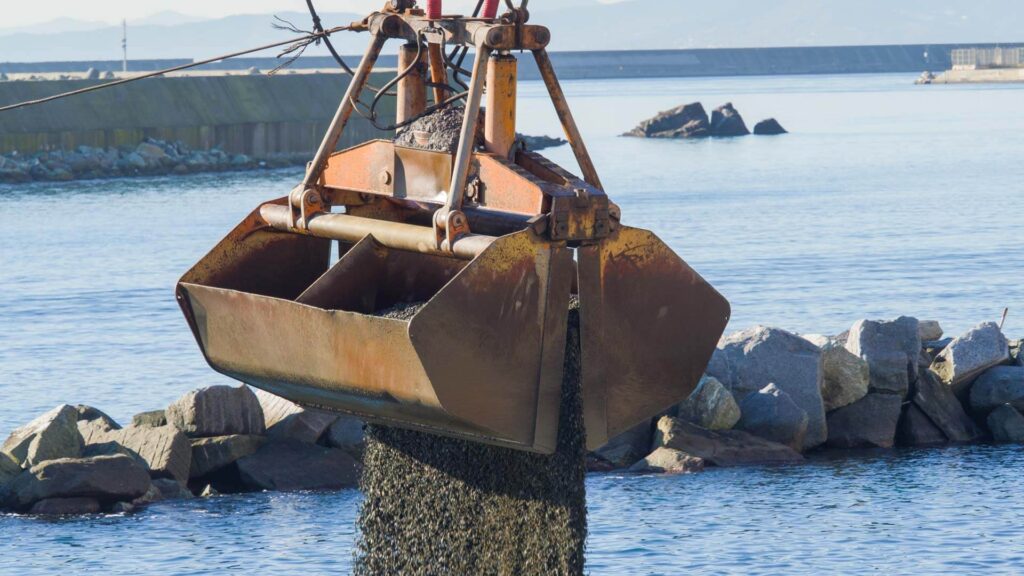
Implementing advanced maintenance strategies is essential for reducing wear and tear in mechanical dredging equipment. The demanding nature of dredging, combined with exposure to abrasive materials and harsh environmental conditions, increases the risk of equipment failure and costly downtime. By adopting proactive maintenance techniques and leveraging modern technology, dredging operators can extend equipment lifespan, improve operational efficiency, and reduce overall maintenance costs. Below are key maintenance strategies to enhance the performance and durability of mechanical dredging equipment.
1. Regular Inspection and Monitoring
Establishing a consistent inspection and monitoring routine is critical for identifying early signs of wear and preventing small issues from escalating into major failures.
- Establishing a Consistent Inspection Schedule
Creating a detailed maintenance schedule helps ensure that all components, including booms, buckets, hydraulic systems, and cutting edges, are inspected at regular intervals. This allows operators to catch signs of wear before they lead to equipment failure.
- Using Data from Onboard Sensors and Monitoring Systems
Modern mechanical dredging equipment is equipped with sensors that monitor factors such as pressure, vibration, and temperature. Analyzing this data provides real-time insight into equipment health and helps operators detect anomalies before they become critical.
- Identifying Early Signs of Wear and Component Failure
Signs of early wear include increased vibration, reduced digging efficiency, and fluid leakage. Addressing these issues promptly helps prevent more extensive damage and reduces the need for costly repairs.
2. Wear-Resistant Materials and Coatings
Upgrading to high-performance materials and protective coatings can significantly reduce the effects of abrasion and corrosion in mechanical dredging operations.
- Upgrading to High-Strength Steel and Corrosion-Resistant Alloys
Components such as cutting edges, bucket teeth, and arms experience constant wear during dredging. Replacing standard materials with high-strength steel or corrosion-resistant alloys extends the lifespan of these components and enhances resistance to impact and stress.
- Applying Protective Coatings to Buckets, Arms, and Cutting Edges
Anti-corrosion coatings, including ceramic and epoxy-based products, provide a protective barrier against abrasive materials and harsh environmental conditions such as saltwater. These coatings reduce the rate of wear and lower the frequency of part replacement.
- Using Ceramic or Carbide-Tipped Cutting Tools
Carbide and ceramic-tipped tools offer increased resistance to abrasion and impact. These materials maintain their sharpness longer, improving cutting efficiency and reducing downtime caused by dull or worn cutting edges.
3. Lubrication and Hydraulic System Maintenance
Effective lubrication and hydraulic system maintenance are essential for reducing friction, preventing overheating, and maintaining smooth equipment operation.
- Proper Lubrication of Moving Parts to Reduce Friction and Heat Buildup
Regular lubrication of moving components, including pins, bushings, and hydraulic cylinders, reduces metal-on-metal contact and minimizes wear caused by friction and heat. High-performance synthetic lubricants are particularly effective in high-stress environments.
- Regular Hydraulic Fluid Testing and Replacement
Hydraulic systems are critical in both hydraulic vs mechanical dredging operations. Testing hydraulic fluid for contamination and proper viscosity ensures optimal performance and prevents damage to seals, pumps, and cylinders.
- Monitoring and Repairing Leaks in Hydraulic Systems
Even small hydraulic leaks can lead to reduced pressure, decreased efficiency, and contamination of the hydraulic fluid. Regular inspections of hydraulic lines, seals, and fittings help identify and address leaks before they compromise the system.
4. Operator Training and Best Practices
Proper training ensures that equipment is operated correctly, reducing the risk of overloading, improper handling, and premature wear.
- Providing Comprehensive Training for Dredge Operators
Operators should receive thorough training on the specific type of mechanical dredging equipment they are using. This includes understanding load capacities, operating limitations, and proper handling techniques.
- Educating Operators on Proper Loading, Handling, and Maneuvering Techniques
Improper loading and handling place unnecessary stress on dredging equipment. Training operators on proper bucket positioning, load distribution, and swing angles helps minimize mechanical stress and extends equipment lifespan.
- Encouraging Real-Time Feedback and Communication with Maintenance Teams
Operators are often the first to notice unusual vibrations, noises, or performance changes. Creating a communication channel between operators and maintenance teams ensures that issues are reported and addressed quickly.
5. Predictive Maintenance Using Technology
Advancements in dredging technology have made predictive maintenance more accessible and effective. Predictive maintenance systems help prevent unexpected failures by anticipating problems before they occur.
- Installing Onboard Sensors to Monitor Vibration, Temperature, and Stress
Sensors integrated into dredging equipment collect real-time data on key performance indicators. Monitoring changes in vibration patterns, pressure drops, and heat levels allows for early detection of component failure.
- Using Predictive Maintenance Software to Anticipate Failures
AI-driven predictive maintenance software analyzes sensor data to identify patterns and predict when a component is likely to fail. This allows operators to schedule repairs before the problem leads to equipment downtime.
- Automating Maintenance Scheduling Based on Real-Time Data
Automated maintenance scheduling based on real-time performance data ensures that equipment is serviced at the optimal time. This prevents over-maintenance (which increases costs) and under-maintenance (which increases the risk of failure).
Upgrading and Retrofitting Dredging Equipment
To maximize the efficiency and lifespan of mechanical dredging equipment, regular upgrades and retrofits are essential. Over time, dredging equipment experiences structural fatigue, wear on moving parts, and reduced performance due to outdated technology. Upgrading key components and modernizing mechanical and hydraulic systems can significantly enhance overall performance, reduce downtime, and improve operational efficiency. By investing in strategic upgrades, dredging operators can take full advantage of the latest advancements in materials, design, and control systems, reinforcing the advantages of mechanical dredging over other dredging methods, such as hydraulic dredging.
1. Replacing Outdated Components
Worn-out or outdated components are one of the primary causes of reduced performance in mechanical dredging equipment. Replacing and upgrading critical parts helps improve durability and extend equipment lifespan.
- Upgrading Booms, Arms, and Cutting Edges to Improve Durability
Booms and arms experience constant stress and impact during dredging, leading to fatigue and eventual failure. Replacing them with high-strength steel or reinforced alloys enhances durability and allows the equipment to handle heavier loads more effectively. Upgrading cutting edges to carbide or ceramic-tipped versions increases wear resistance and improves cutting efficiency, especially when handling abrasive materials like sand and gravel.
- Enhancing Structural Reinforcements for High-Stress Areas
High-stress areas, such as pivot points and mounting joints, are prone to cracking and deformation due to repetitive motion and heavy loads. Reinforcing these areas with thicker plates, higher-grade steel, and improved welding techniques increases structural integrity and reduces the risk of equipment failure during operation.
2. Modernizing Hydraulic and Mechanical Systems
Old hydraulic and mechanical systems often suffer from reduced efficiency and increased maintenance requirements. Modernizing these systems improves performance and reduces energy consumption, resulting in more reliable dredging operations.
- Replacing Old Hydraulic Systems with More Efficient Models
Outdated hydraulic systems tend to lose pressure, develop leaks, and require frequent repairs. Upgrading to modern, high-efficiency hydraulic systems improves response time, increases digging power, and reduces energy consumption. Modern hydraulic systems are also more resistant to overheating and pressure loss, providing greater consistency during prolonged dredging operations.
- Installing High-Performance Pumps and Motors
High-performance pumps and motors deliver greater output while consuming less energy. Replacing outdated pumps with modern designs increases material throughput and allows the dredge to handle higher-density slurries without overloading the system. High-efficiency motors also reduce fuel or energy consumption, leading to lower operating costs.
3. Improving Operator Comfort and Control Systems
Operator performance directly impacts the efficiency and effectiveness of mechanical dredging operations. Upgrading control systems and improving operator comfort enhances precision and reduces fatigue, allowing operators to work more efficiently.
- Upgrading to Joystick or Touch-Screen Controls for Precision
Modern joystick and touch-screen controls offer greater precision and responsiveness compared to traditional lever-based systems. Joystick controls allow for smoother operation of the boom and bucket, improving accuracy when handling delicate or heavy materials. Touch-screen interfaces provide real-time data on equipment performance, helping operators make better decisions during dredging.
- Improving Visibility and Ergonomics to Reduce Operator Fatigue
Poor visibility and uncomfortable operator cabins can reduce focus and increase the likelihood of operator error. Upgrading operator cabins with larger windows, high-visibility cameras, and LED lighting improves situational awareness. Ergonomic seats, climate control, and vibration-dampening systems reduce operator fatigue, improving overall productivity and reducing the risk of mistakes.
Environmental and Regulatory Considerations
Environmental impact and regulatory compliance are critical factors in mechanical dredging operations. Dredging activities can significantly affect aquatic ecosystems, water quality, and sediment stability, making it essential for operators to adopt best practices that minimize environmental disruption. Additionally, compliance with local and international regulations ensures that dredging projects are conducted safely and responsibly. By implementing environmentally friendly practices and staying aligned with regulatory requirements, dredging operators can enhance the advantages of mechanical dredging while minimizing negative environmental consequences.
Minimizing Environmental Impact
Effective mechanical dredging requires a balance between achieving operational goals and protecting the surrounding environment. Careful planning and the use of eco-friendly materials can reduce the impact on aquatic ecosystems and water quality.
- Reducing Sediment Disruption and Material Spillage
One of the main environmental challenges of mechanical dredging is sediment disruption, which can lead to increased turbidity and reduced water quality. Using precise dredging methods such as clamshell or bucket dredging helps minimize the release of fine sediment into the water column. Additionally, installing silt curtains and containment barriers around the dredging site reduces the spread of disturbed sediment and prevents contamination of nearby ecosystems.
- Using Eco-Friendly Lubricants and Hydraulic Fluids
Traditional hydraulic fluids and lubricants can be harmful to aquatic life if they leak into the water. Switching to biodegradable and eco-friendly alternatives reduces the risk of environmental contamination. Modern vegetable-based hydraulic fluids and non-toxic lubricants provide effective performance while reducing the environmental footprint of dredging operations. This is especially important in protected marine habitats and sensitive ecological zones.
2. Compliance with Safety and Environmental Regulations
Strict compliance with environmental and safety regulations ensures that mechanical dredging projects are conducted legally and responsibly. Failing to meet these requirements can lead to costly fines, project shutdowns, and long-term damage to the operator’s reputation.
- Following Local and International Dredging Regulations
Dredging activities are regulated at the local, national, and international levels to protect aquatic ecosystems and prevent water contamination. Operators must obtain the necessary permits and adhere to specific guidelines regarding sediment disposal, water quality protection, and wildlife preservation. Regulations such as the Clean Water Act (in the U.S.) and the London Convention (internationally) outline best practices and restrictions for dredging projects.
- Conducting Environmental Impact Assessments Before Starting Operations
An environmental impact assessment (EIA) is essential for identifying potential risks and developing strategies to mitigate environmental damage. An EIA evaluates factors such as sediment composition, water quality, marine habitats, and species at risk. By conducting thorough assessments, operators can adjust dredging methods, implement protective measures, and ensure compliance with environmental guidelines.
Comparing Hydraulic vs Mechanical Dredging in Terms of Maintenance
Maintenance plays a crucial role in the efficiency and lifespan of dredging equipment. Understanding the differences between hydraulic vs mechanical dredging in terms of maintenance complexity, durability, and cost is essential for choosing the most suitable dredging method for a project. While hydraulic systems offer high efficiency for fine material removal, mechanical dredging provides greater durability and simpler maintenance, making it a preferred option for handling heavy and abrasive materials. Below is a detailed comparison of the maintenance demands of hydraulic and mechanical dredging systems.
1. Maintenance Complexity
The complexity of maintaining dredging equipment varies significantly between hydraulic and mechanical systems.
- Hydraulic Dredging:
Hydraulic dredging systems are more complex due to the need for pumps, hoses, and hydraulic fluid systems. Maintaining hydraulic equipment requires frequent monitoring of fluid levels, pressure consistency, and system integrity. Hydraulic fluid must be tested and replaced regularly to prevent contamination and pressure loss. Leaks or failures in the hydraulic system can cause significant downtime and require skilled technicians to diagnose and repair.
- Mechanical Dredging:
Mechanical dredging systems have fewer moving parts and simpler designs, making them easier to maintain. Most maintenance for mechanical dredging equipment involves inspecting and replacing structural components such as booms, arms, and bucket teeth. Lubrication of moving joints and monitoring for signs of metal fatigue or wear are essential but generally require less technical expertise compared to hydraulic system maintenance.
2. Durability and Longevity
Durability and lifespan depend on the type of material being handled and the frequency of use.
- Mechanical Dredging:
Mechanical dredging equipment tends to last longer when properly maintained because the structural components (such as booms, arms, and buckets) are made from heavy-duty materials designed to withstand abrasive materials. High-strength steel and reinforced alloys improve resistance to wear and impact, ensuring that mechanical dredging equipment remains operational even under tough conditions. The simplicity of mechanical systems also reduces the likelihood of critical system failures.
- Hydraulic Dredging:
Hydraulic dredging systems are more sensitive to wear and require precise calibration and regular monitoring to maintain peak performance. Hoses, pumps, and valves experience high pressure and must be inspected frequently for signs of leaks or wear. Over time, hydraulic components can degrade due to contamination, heat buildup, and fluid breakdown, requiring more frequent replacements and system recalibration.
3. Cost of Maintenance
Maintenance costs vary depending on the type of dredging system and the frequency of part replacement or repair.
- Hydraulic Dredging:
Hydraulic systems have higher maintenance costs due to the complexity of the equipment and the need for specialized components. Hydraulic fluid, filters, and hoses must be replaced regularly, and any failure in the system can result in costly repairs. Additionally, maintaining the correct pressure and preventing contamination requires ongoing monitoring and adjustments, adding to overall maintenance expenses.
- Mechanical Dredging:
Mechanical dredging maintenance costs are primarily focused on part replacement and structural repairs. Bucket teeth, cutting edges, and booms are subject to high levels of wear and need to be replaced periodically. However, these components are typically more affordable to replace compared to hydraulic pumps and valves. Maintenance for mechanical dredging also requires fewer specialized tools and technicians, reducing overall labor costs.
Conclusion
Effective maintenance is essential for maximizing the performance and lifespan of dredging equipment, especially in demanding mechanical dredging operations. Mechanical dredging offers distinct advantages in terms of handling abrasive materials, providing greater precision, and performing effectively in shallow or confined areas. However, the physical nature of mechanical dredging leads to significant wear and tear on structural components, making regular maintenance and strategic upgrades critical for sustaining operational efficiency. By implementing advanced maintenance strategies such as predictive maintenance, upgrading to wear-resistant materials, and reinforcing high-stress components, operators can significantly reduce downtime and extend equipment longevity.
When comparing hydraulic vs mechanical dredging, mechanical systems generally offer greater durability and simpler maintenance, whereas hydraulic systems require more frequent fluid changes and calibration due to their complexity. While hydraulic dredging excels in handling fine sediments and operating continuously over large areas, mechanical dredging is better suited for heavy and compacted materials. By understanding the maintenance demands of each system and adopting proactive maintenance practices, operators can optimize dredging performance, reduce operational costs, and extend the lifespan of their equipment.


